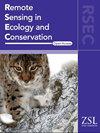无人机摄影测量揭示了印度太平洋上儒艮不同的身体状况
IF 4.3
2区 环境科学与生态学
Q1 ECOLOGY
引用次数: 0
摘要
身体状况的监测反映了个体能量储备的状态,可以为种群减少提供早期预警信号,促进及时的保护行动。然而,对于稀有和难以捉摸的海洋哺乳动物物种在其整个活动范围内的身体状况的环境和人为驱动因素知之甚少。我们评估了印度-太平洋范围内濒危儒艮(dugong dugon)身体状况的全球模式和驱动因素。为此,我们应用了为相关海牛开发的身体状况指数(BCI),该指数基于脐带围(近似为最大宽度乘以π)与无人机图像中测量的直体长的比率。为了覆盖儒艮的整个活动范围,我们利用了社交媒体上发布的无人机镜头。结合科学调查的视频,社交媒体上的视频提供了18个国家272只儒艮的身体状况估计。尽管样本规模相对于当地人口规模较小,但我们发现,在全球人口最多的新喀里多尼亚、阿拉伯联合酋长国、澳大利亚和卡塔尔,儒艮的BCI更好,也就是说,个体“更丰满”。在像莫桑比克这样儒艮数量很少的国家,儒艮BCI相对较差,这表明身体状况和儒艮数量之间存在联系。利用统计模型,在控制季节和个体影响的情况下,研究了儒艮BCI的潜在环境和人为驱动因素。BCI随人类重力(一个综合人类对热带珊瑚礁压力的变量)而降低,但随人均GDP而增加,表明经济财富对儒艮能量状态有积极影响。BCI与海洋保护区面积呈圆顶关系,表明空间保护不足以维持儒艮的良好状态。我们的研究首次通过无人机摄影测量对儒艮的身体状况进行了评估,强调了这种非侵入性、快速和低成本的方法对监测难以捉摸的海洋哺乳动物的价值。本文章由计算机程序翻译,如有差异,请以英文原文为准。
Drone photogrammetry reveals contrasting body conditions of dugongs across the Indo‐Pacific
The monitoring of body condition, reflecting the state of individuals' energetic reserves, can provide early warning signals of population decline, facilitating prompt conservation actions. However, environmental and anthropogenic drivers of body condition are poorly known for rare and elusive marine mammal species over their entire ranges. We assessed the global patterns and drivers of body condition for the endangered dugong (Dugong dugon ) across its Indo‐Pacific range. To do so, we applied the body condition index (BCI) developed for the related manatee based on the ratio of umbilical girth (approximated as maximum width times π), to straight body length measured in drone images. To cover the entire dugong's range, we took advantage of drone footage published on social media. Combined with footage from scientific surveys, social media footage provided body condition estimates for 272 individual dugongs across 18 countries. Despite small sample sizes relative to local population sizes, we found that dugong BCI was better, that is, individuals were ‘plumper’, in New Caledonia, the United Arab Emirates, Australia and Qatar where populations are the largest globally. Dugong BCI was comparatively poorer in countries hosting very small dugong populations such as Mozambique, suggesting a link between body condition and population size. Using statistical models, we then investigated potential environmental and anthropogenic drivers of dugong BCI, while controlling for seasonal and individual effects. The BCI decreased with human gravity, a variable integrating human pressures on tropical reefs, but increased with GDP per capita, indicating that economic wealth positively affects dugong energetic state. The BCI also showed a dome‐shaped relationship with marine protected area coverage, suggesting that extensive spatial protection is not sufficient to maintain dugongs in good state. Our study provides the first assessment of dugong body condition through drone photogrammetry, underlining the value of this non‐invasive, fast and low‐cost approach for monitoring elusive marine mammals.
求助全文
通过发布文献求助,成功后即可免费获取论文全文。
去求助
来源期刊

Remote Sensing in Ecology and Conservation
Earth and Planetary Sciences-Computers in Earth Sciences
CiteScore
9.80
自引率
5.50%
发文量
69
审稿时长
18 weeks
期刊介绍:
emote Sensing in Ecology and Conservation provides a forum for rapid, peer-reviewed publication of novel, multidisciplinary research at the interface between remote sensing science and ecology and conservation. The journal prioritizes findings that advance the scientific basis of ecology and conservation, promoting the development of remote-sensing based methods relevant to the management of land use and biological systems at all levels, from populations and species to ecosystems and biomes. The journal defines remote sensing in its broadest sense, including data acquisition by hand-held and fixed ground-based sensors, such as camera traps and acoustic recorders, and sensors on airplanes and satellites. The intended journal’s audience includes ecologists, conservation scientists, policy makers, managers of terrestrial and aquatic systems, remote sensing scientists, and students.
Remote Sensing in Ecology and Conservation is a fully open access journal from Wiley and the Zoological Society of London. Remote sensing has enormous potential as to provide information on the state of, and pressures on, biological diversity and ecosystem services, at multiple spatial and temporal scales. This new publication provides a forum for multidisciplinary research in remote sensing science, ecological research and conservation science.
 求助内容:
求助内容: 应助结果提醒方式:
应助结果提醒方式:


